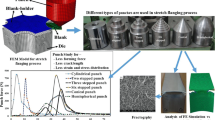Abstract
Dissimilar materials, such as aluminum alloys, magnesium alloys, and advanced high-strength steel, are being increasingly used in vehicle structures while the flangeability of lightweight materials is of great challenges to the traditional process. In the presented study, the multi-step flanging in one press stroke accomplished by a novel punch with a notch was designed. The concept of incremental forming was implemented to improve the punch shape of stretch flanging and enhance the stretch-flangeability of advanced high-strength steel. Analytical solutions and numerical simulations were carried out to investigate the deformation mechanism and thickness distribution. Compared with the single-step forming punch (SFP), flanging process was divided into three steps in one press stroke by multi-step forming punch (MFP), which combined multi-stage characteristic of incremental sheet forming with high efficiency of traditional stamping. The results showed that the maximum tensile strain with MFP dropped from 0.406 to 0.28 at the edge of the deformed blank comparing with the single-step flanging by transferring large strain around the stretch corner edge to straight flanging region, which was in agreement with the theoretical analysis. In addition, excessive thinning was suppressed with MFP which decreased from 25.63 to 18.13% by sacrificing punch stroke that increased from 23 to 53 mm. Both the theoretical analysis and simulation results illustrated the validity of MFP for advanced high-strength steel.
Similar content being viewed by others
References
Takahashi M, Uenishi A, Yoshida H, Kuriyama H (2007) Advanced high strength steels for automobile body structures. In: Chandra T, Tsuzaki K, Militzer M, Ravindran C (eds) Thermec 2006, Pts 1-5, vol 539-543. Materials Science Forum. pp 4386-+. https://doi.org/10.4028/www.scientific.net/MSF.539-543.4386
Hu P, Li DY, Li YX (2003) Analytical models of stretch and shrink flanging. Int J Mach Tools Manuf 43(13):1367–1373. https://doi.org/10.1016/s0890-6955(03)00150-0
Huang Y-M (2007) An elasto-plastic finite element analysis of the sheet metal stretch flanging process. Int J Adv Manuf Technol 34(7–8):641–648. https://doi.org/10.1007/s00170-007-0958-3
Yoon JI, Jung J, Joo S-H, Song TJ, Chin K-G, Seo MH, Kim S-J, Lee S, Kim HS (2016) Correlation between fracture toughness and stretch-flangeability of advanced high strength steels. Mater Lett 180:322–326. https://doi.org/10.1016/j.matlet.2016.05.145
Kacem A, Krichen A, Manach PY, Thuillier S, Yoon JW (2013) Failure prediction in the hole-flanging process of aluminium alloys. Eng Fract Mech 99:251–265. https://doi.org/10.1016/j.engfracmech.2012.12.018
Yu X, Chen J, Chen J (2016) Influence of curvature variation on edge stretchability in hole expansion and stretch flanging of advanced high-strength steel. Int J Adv Manuf Technol 86(1–4):1083–1094. https://doi.org/10.1007/s00170-015-8251-3
Thipprakmas S, Phanitwong W (2011) Finite element analysis of flange-forming direction in the hole flanging process. Int J Adv Manuf Technol 61(5–8):609–620. https://doi.org/10.1007/s00170-011-3721-8
Feng X, Zhongqin L, Shuhui L, Weili X (2004) Study on the influences of geometrical parameters on the formability of stretch curved flanging by numerical simulation. J Mater Process Technol 145(1):93–98. https://doi.org/10.1016/s0924-0136(03)00866-5
Leu DK, Chen TC, Huang YM (1999) Influence of punch shapes on the collar-drawing process of sheet steel. J Mater Process Technol 88(1–3):134–146. https://doi.org/10.1016/s0924-0136(98)00385-9
Huang YM, Chien KH (2001) Influence of the punch profile on the limitation of formability in the hole-flanging process. J Mater Process Technol 113(1–3):720–724. https://doi.org/10.1016/s0924-0136(01)00597-0
Huang YM, Chien KH (2002) Influence of cone semi-angle on the formability limitation of the hole-flanging process. Int J Adv Manuf Technol 19(8):597–606. https://doi.org/10.1007/s001700200065
Sriram S, Chintamani J (2005) Guidelines for stretch flanging advanced high strength steels. In: Smith LM, Pourboghrat F, Yoon JW, Stoughton TB (eds) Numisheet 2005: Proceedings of the 6th International Conference and Workshop on Numerical Simulation of 3D Sheet Metal Forming Processes, Pts A and B, vol 778. Aip Conference Proceedings. pp 681–686
Allwood JM, Shouler DR, Tekkaya AE (2007) The increased forming limits of incremental sheet forming processes. Key Eng Mater 344:621–628. https://doi.org/10.4028/www.scientific.net/KEM.344.621
Centeno G, Silva MB, Cristino VAM, Vallellano C, Martins PAF (2012) Hole-flanging by incremental sheet forming. Int J Mach Tools Manuf 59:46–54. https://doi.org/10.1016/j.ijmachtools.2012.03.007
Cao T, Lu B, Cao J, Chen J (2017) Experimental investigations on the forming mechanism of a new incremental stretch-flanging strategy with a featured tool. Int J Adv Manuf Technol 92(5–8):2953–2964. https://doi.org/10.1007/s00170-017-0355-5
Abe Y, K-i M, Norita K (2013) Gradually contacting punch for improving stretch flangeability of ultra-high strength steel sheets. CIRP Ann 62(1):263–266. https://doi.org/10.1016/j.cirp.2013.03.059
Syafiq YM, Hamedon Z, Azila Aziz W, Razlan Yusoff A (2017) Prevention of crack in stretch flanging process using hot stamping technique. IOP Conference Series: Materials Science and Engineering 257:012071. https://doi.org/10.1088/1757-899x/257/1/012071
Chen L, Chen H, Wang Q, Li Z (2015) Studies on wrinkling and control method in rubber forming using aluminium sheet shrink flanging process. Mater Des (1980–2015) 65:505–510. https://doi.org/10.1016/j.matdes.2014.09.057
Li D, Luo Y, Peng Y, Hu P (2007) The numerical and analytical study on stretch flanging of V-shaped sheet metal. J Mater Process Technol 189(1–3):262–267. https://doi.org/10.1016/j.jmatprotec.2007.01.035
Shih H-C (2016) Friction and die wear in stamping prephosphated advanced high strength steels. Sae Int J Mater Manuf 9(2):481–487. https://doi.org/10.4271/2016-01-0356
Valente Tigrinho LM, Chemin Filho RA, Prestes Marcondes PV (2013) Fracture analysis approach of DP600 steel when subjected to different stress/strain states during deformation. Int J Adv Manuf Technol 69(5–8):1017–1024. https://doi.org/10.1007/s00170-013-5104-9
Matsuno T, Sato K, Okamoto R, Mizumura M, Suehiro M (2016) Synergy effect of shear angle and anisotropic material ductility on hole-expansion ratio of high-strength steels. J Mater Process Technol 230:167–176. https://doi.org/10.1016/j.jmatprotec.2015.10.018
Chiriac C, Shi MF, Link TM (2012) The Prestrain effect on the sheared edge flangeability of dual phase 780 steels. 1. https://doi.org/10.4271/2012-01-0533
Ma B, Liu ZG, Jiang Z, Wu X, Diao K, Wan M (2016) Prediction of forming limit in DP590 steel sheet forming: an extended fracture criterion. Mater Des 96:401–408. https://doi.org/10.1016/j.matdes.2016.02.034
Funding
The authors received financial support from Project for the Central Universities supported by the Fundamental Research Funds under Grant No. CDJZR14130006.
Author information
Authors and Affiliations
Corresponding author
Rights and permissions
About this article
Cite this article
Wang, M., Wang, S. & Li, Z. Multi-step forming punch (MFP) for improving stretch-flangeability of advanced high-strength steel. Int J Adv Manuf Technol 99, 1627–1638 (2018). https://doi.org/10.1007/s00170-018-2573-x
Received:
Accepted:
Published:
Issue Date:
DOI: https://doi.org/10.1007/s00170-018-2573-x




